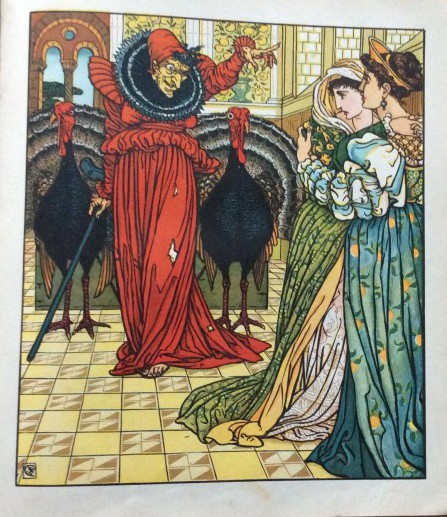Inspiring Young Readers
 posted on 27 Jan 2016
posted on 27 Jan 2016
Aladdin's Picture Book by Walter Crane
Walter Crane was one of the great innovative artists of the nineteenth century. He was part of the Arts and Crafts movement, inspired by Socialist ideals that valued an aesthetically beautiful everyday environment as an important part of creating a more civilised and ultimately fairer society. With William Morris and others, Crane helped to change traditional ideas about design that remain powerful even now. One of the big influences at the time was the art of Japan that people had started to become aware of as a result of increased trade with and travel to the Far East. It is difficult to appreciate how the more stylised design and vivid colours of this country were completely fresh at the time. Another new inspiration was that of the natural world, particularly the detailed patterns of leaves and flowers which started to feature everywhere in paintings, ceramics, tiles, printed fabrics and wallpaper. Their more subtle colours in nature were often transformed and given a stronger and deeper treatment by these artists which contributed to a feeling of rich, density that bordered on the claustrophobic.
Wonderfully illustrated books were starting to become more common as desirable gift items for children of more affluent families and also reflected the change in design style. Crane illustrated many such books and Aladdin's Picture Book published in 1876 was one of the finest. The dark navy blue front cover with an engraved picture of Aladdin walking towards an orange tree is subdued but graceful. The enclosed design on the back cover contains three stylised symbols that represent the four different stories contained in the book: 'Aladdin and the wonderful Lamp'; ' The Yellow Dwarf'; ' Princess Belle Etoile'; and ' The Hind in the Wood'
The opening very thin pages are blank and cream coloured lulling the reader into thinking perhaps that not much is going to happen. But then the first of twenty four gorgeous illustrations appears depicting The Boy being approached by the wicked magician of the story. We see Aladdin standing nonchalantly in a street with his hands in his pockets. Behind him at his feet, two other boys sprawl on the street playing a game. In the background we see lanterns, steps, birds in a blue sky and a woman looking down on the scene from an upstairs window. Every little bit of the beautifully balanced composition on the page is stuffed with action, pattern and colour.
The written text of each story is in quite a large font, although oddly not consistent in size. This may indicate that it was aimed at a young readership, or possibly this was also part of the overall bold design. The next illustration in the book is truly breathtaking with Aladdin clad in a vibrantly gold coloured robe flecked with orange as he reaches up for the lamp. This time we see a densely patterned tiled interior, predominately blue with finely detailed planters that contain flowering shrubs in oranges and pinks. In the distance there is an arched window and a doorway with a suggestion of an abundantly fertile garden.
I could enthuse about every one of the following illustrations that include some impressive double page spreads, but I will describe just one more and then leave you to browse through a few more examples below. This time we see an armoured knight standing with his sword and shield reflecting the two headed dragon whose tail curls behind him twining around the base of an orange tree in the background. The vertical lines of the armour and the trees in the distance contrast with the curves of the dragon. Once again, the overall composition is totally balanced and the colours are intense.
The photographs here do not really do justice to the depth of colours of the original illustrations in my first edition copy so, if you get a chance to enjoy the book first hand, I strongly recommend it although you may have to pay about £100 for the pleasure.
Karen Argent
26th January 2016





